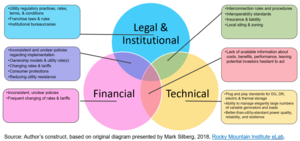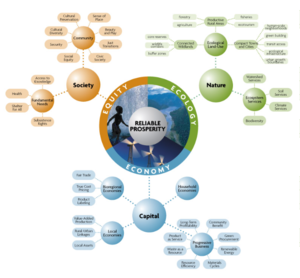LISTING IN ALPHABETICAL ORDER FOR THE TIME BEING. PLEASE FEEL FREE TO SUGGEST ANY ALTERNATE AND SUPERIOR ORGANIZING PRINCIPLES[edit | edit source]
- Climate change: How is climate change affecting agriculture in different regions? What plants are best to consider for our newly destablized climate? What crops need to be considered for moving to new locations because of climate extremes, and what kinds of extremes (hot/cold, wet/dry, high winds, hail, etc.). Examples already include: wine grapes, apples, citrus fruits, and peaches, also changes in ranges for fish and other ocean-based foods.
- Include discussion about the COP28 decision to expand linkages between agricultural practices and GHG reductions.
- Ecovillage failure modes, causes, stages of progress, etc. Can we document what stage of development different “failed” ecovillages were in, when the failures occurred? Are there common “valley of death” challenges that make ecovillage success especially difficult to achieve? What are the vulnerabilities? What are options for avoiding or overcoming such challenges?
- I. Zelenika and J.M. Pearce, “Barriers to Appropriate Technology Growth in Sustainable Development”, Journal of Sustainable Development 4(6), 12-22 (2011). Open access: https://www.academia.edu/1508504/Barriers_to_Appropriate_Technology_Growth_in_Sustainable_Development
- Energy Conservation, Efficiency -- Conscious and conscientious reductions in energy use. What are all the ideas about using less energy due to personal choices, like voluntary simplicity, resource sharing, transportation planning and "trip stacking." Where do all these topics belong in the hierarchy of tools, techniques, and practices?
- Examples: no air travel. Reduce, reuse, recycle, repair. Use less.
- Governance, Decision-Making, and Social Dimensions. How shall we incorporate governance, decision-making, and social dimensions of ecovillages and intentional communities into our growing catalog of tools, techniques, and practices? Might we incorporate a "petal chart" for explaining this purpose? Here are a few links about petal charts:
 |
 |
|---|
- Life Stages for both Ecovillages and for the communities of people who are living in Ecovillages.
- What life stages from pregancy to birth, toddler, youth, teen, young adult, mature, etc. (including possible eventual decline and death) describe ecovillages? Please help flesh out a systematic listing of stages. For each major life stage, include references to the best few books about each topic.
- Chelsea Green Publishing, https://www.chelseagreen.com/?s=ecovillage, https://www.chelseagreen.com/product-category/farming-homesteading/, https://www.chelseagreen.com/self-sufficient/, https://www.chelseagreen.com/product-category/community-resilience/
- Foundation for Intentional Communities, https://www.ic.org/intentional-community-books/
- Global Ecovillage Network (GEN), https://ecovillage.org/store/ and https://ecovillage.org/solution/open-source-appropriate-technology-osat/
- Island Press, https://islandpress.org/search?keywords=intentional%20community&type=book
- New Society Publishers, https://newsociety.com/subjects/conscious-community
- [Editor note: What other great publishers regularly produce books or other materials to aide those who are working to establish or grow ecovillages?]
- Similarly for ecovillage communities, can we help people understand which ones are most suitable for residents of various life-stages from birth thru death? Many people will want to understand provisions for every age level, and it seems clear that eventual accessibility of all kinds (for those too young, or too old, or for whatever reasons have physical challenges that need certain accommodations to be comfortable and safe in their surroundings).
- Examples: Dementia Village living: https://www.dementiavillage.com/ Also New York Times article: https://www.nytimes.com/2023/07/03/realestate/dementia-villages-senior-living.html Also
- Examples: Ideas for young children (Christopher Alexander patterns for safe play for toddlers and youth).
- Examples: The Green House Elder Care Project. https://thegreenhouseproject.org/
- Example: Concept of a special intentional community for people "on the autism spectrum" who may need special accommodations for sensory inputs.
- What life stages from pregancy to birth, toddler, youth, teen, young adult, mature, etc. (including possible eventual decline and death) describe ecovillages? Please help flesh out a systematic listing of stages. For each major life stage, include references to the best few books about each topic.
- Maps and databases of ecovillages, combining data from multiple information sources? Can we make a comprensive listing? Can it include database categories for searching, such as: year founded, geographic location types (by climate type, country, hemisphere, etc.), major focuses, etc.? Where else do comprehensive directories exist? Does someone know enough about mapping and databases to help achieve this goal? See, for starters:
- Ecovillage Map
- Ecovillage Map / Data
- Ecovillages of Western Europe (2023 map). https://www.google.com/maps/d/viewer?mid=1hIFFKg8O2yHTdo7UG3AnrvpvXGs&hl=en_US&ll=45.69930239995541%2C-6.021432437499925&z=4
- Ecovillages of Eastern Europe. https://www.google.com/maps/d/viewer?mid=1H_74Y83osRm2Bc5vQ06127qUmLM&hl=en_US&ll=48.74697245365909%2C17.634360875000098&z=4